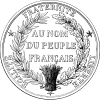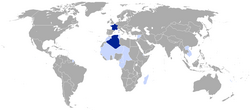
Back Franse Derde Republiek Afrikaans الجمهورية الفرنسية الثالثة Arabic الجمهوريه الفرنسيه التالته ARZ Tercer República Francesa AST Üçüncü Fransa Respublikası Azerbaijani اۆچونجو فرانسه جومهوریتی AZB Трэцяя французская рэспубліка Byelorussian Трета френска република Bulgarian Trede Republik c'hall Breton Tercera República Francesa Catalan
French Republic République française (French) | |
|---|---|
| 1870–1940 | |
| Motto: Liberté, égalité, fraternité ("Liberty, Equality, Fraternity") | |
| Anthem: La Marseillaise | |
Great Seal of France:  | |
 The French Republic in 1939
| |
 Territories and colonies of the French Republic in 1939
| |
| Capital and largest city | Paris 48°52′13″N 02°18′59″E / 48.87028°N 2.31639°E |
| Common languages | French (official), several others |
| Religion | |
| Demonym(s) | French |
| Government |
|
| President | |
• 1871–1873 (first) | Adolphe Thiers |
• 1932–1940 (last) | Albert Lebrun |
| Prime Minister | |
• 1870–1871 (first) | Louis Jules Trochu |
• 1940 (last) | Philippe Pétain |
| Legislature | Parliament |
| Senate | |
| Chamber of Deputies | |
| History | |
• Proclamation by Leon Gambetta | 4 September 1870 |
| 15 November 1884 | |
• France enters the Great War | 3 August 1914 |
| 28 June 1919 | |
• France enters World War II | 3 September 1939 |
| 10 May – 25 June 1940 | |
• Vichy France declared | 10 July 1940 |
| Area | |
| 1894 (Metropolitan France) | 536,464 km2 (207,130 sq mi) |
| 1938 (including colonies) | 13,500,000[1][2] km2 (5,200,000 sq mi) |
| Population | |
• 1938 (including colonies) | 150,000,000[3] |
| Currency | French Franc |
| ISO 3166 code | FR |
| History of France |
|---|
 |
| Timeline |
| Topics |
|
|
The French Third Republic (French: Troisième République, sometimes written as La IIIe République) was the system of government adopted in France from 4 September 1870, when the Second French Empire collapsed during the Franco-Prussian War, until 10 July 1940, after the Fall of France during World War II led to the formation of the Vichy government. The French Third Republic was a parliamentary republic.
The early days of the French Third Republic were dominated by political disruption caused by the Franco-Prussian War of 1870–1871, which the French Third Republic continued to wage after the fall of Emperor Napoleon III in 1870. Social upheaval and the Paris Commune preceded the final defeat. The German Empire, proclaimed by the invaders in Palace of Versailles, annexed the French regions of Alsace (keeping the Territoire de Belfort) and Lorraine (the northeastern part, i.e. present-day department of Moselle). The early governments of the French Third Republic considered re-establishing the monarchy, but disagreement as to the nature of that monarchy and the rightful occupant of the throne could not be resolved. Consequently, the French Third Republic, originally envisioned as a provisional government, instead became the permanent form of government of France.
The French Constitutional Laws of 1875 defined the composition of the Third Republic. It consisted of a Chamber of Deputies and a Senate to form the legislative branch of government and a president to serve as head of state. Calls for the re-establishment of the monarchy dominated the tenures of the first two presidents, Adolphe Thiers and Patrice de MacMahon, but growing support for the republican form of government among the French populace and a series of republican presidents in the 1880s gradually quashed prospects of a monarchical restoration.
The Third Republic established many French colonial possessions, including French Indochina, French Madagascar, French Polynesia, and large territories in West Africa during the Scramble for Africa, all of them acquired during the last two decades of the 19th century. The early years of the 20th century were dominated by the Democratic Republican Alliance, which was originally conceived as a centre-left political alliance, but over time became the main centre-right party. The period from the start of World War I to the late 1930s featured sharply polarized politics, between the Democratic Republican Alliance and the Radicals. The government fell less than a year after the outbreak of World War II, when Nazi forces occupied much of France, and was replaced by the rival governments of Charles de Gaulle's Free France (La France libre) and Philippe Pétain's French State (L'État français).
During the 19th and 20th centuries, the French colonial empire was the second largest colonial empire in the world only behind the British Empire; it extended over 13,500,000 km2 (5,200,000 sq mi) of land at its height in the 1920s and 1930s. In terms of population however, on the eve of World War II, France and its colonial possessions totaled only 150 million inhabitants, compared with 330 million for British India alone.
Adolphe Thiers called republicanism in the 1870s "the form of government that divides France least"; however, politics under the Third Republic were sharply polarized. On the left stood reformist France, heir to the French Revolution. On the right stood conservative France, rooted in the peasantry, the Catholic Church, and the army.[4] In spite of France's sharply divided electorate and persistent attempts to overthrow it, the Third Republic endured for 70 years, which makes it the longest-lasting system of government in France since the collapse of the Ancien Régime in 1789.[5]
- ^ Aldrich 1996, p. 304.
- ^ Page, Melvin E., ed. (2003). Colonialism: An International Social, Cultural, and Political Encyclopedia. ABC-CLIO. p. 218. ISBN 9781576073353. Archived from the original on 19 November 2021. Retrieved 23 December 2021.
- ^ Priestley, Herbert Ingram (1938). France overseas: A Study of Modern Imperialism. pp. 440–441.
- ^ Larkin, Maurice (2002). Religion, Politics and Preferment in France since 1890: La Belle Époque and its Legacy. Cambridge University Press. p. 3. ISBN 978-0-521-52270-0.
- ^ "The Night the Old Regime Ended: August 4, 1789 and the French Revolution By Michael P. Fitzsimmons". Penn State University Press. Archived from the original on 7 October 2021. Retrieved 7 October 2021.

